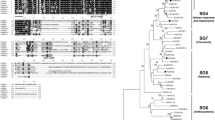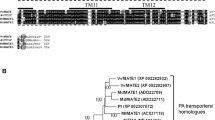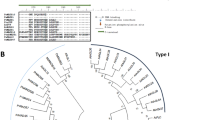Abstract
Stem reorientation in response to inclination in trees has commanded the attention of the research community widely, but the molecular mechanisms of the response are still unknown. The most accepted theory is auxin redistribution in affected tissues. Flavonols have been reported as potent inhibitors of polar auxin transport; however, no reports have shown differential modulation by flavonols within the trunk. Here, transcriptional, microscopic, and chemical approaches were used to analyze the contents of flavonoids in 45° inclined radiata pine seedlings. A time course was established and samples obtained by cutting stems into apical, medial, and basal segments or by longitudinal dissection into upper and lower halves to determine polar distribution of flavonoids. The expression analysis of PrCHS, PrF3H, and PrFLS indicated induction in response to inclination; higher transcript levels were recorded at the basal zone and in the upper half of the stem. A reduction in abundance of PrARP transcripts in addition to immunospecific auxin detection at the lower half of inclined stem was found. Concomitantly, quercetin and kaempferol accumulated in the upper stem half. Our results suggest that stem reorientation is a response to a concerted and differential mechanism that modulates imbalance of auxin distribution in one side of the stem.







Similar content being viewed by others
References
Andersson-Gunnerås S, Hellgren JM, Björklund S, Regan S, Moritz T, Sandberg B (2003) Asymetric expression of poplar ACC oxidase controls ethylene production during gravitational induction of tension wood. Plant J 34:339–349
Beritognolo I, Magel E, Abdel-Latif A, Charpentier JP, Jay-Allemand C, Breton C (2002) Expression of genes encoding chalcone synthase, flavanone 3-hydroxylase and dihydroflavonol 4-reductase correlates with flavanol accumulation during heartwood formation in Juglans nigra. Tree Physiol 22:291–300
Besseau S, Hoffmann L, Geoffroy P, Lapierre C, Pollet B, Legrand M (2007) Flavonoid accumulation in Arabidopsis repressed in lignin synthesis affects auxin transport and plant growth. Plant Cell 19:148–162
Blakeslee JJ, Peer WA, Murphy AS (2005) Auxin transport. Curr Opin Plant Biol 8:494–500
Bouchard R, Bailly A, Blakeslee JJ, Oehring SC, Vincenzetti V, Lee OR et al (2006) Immunophilin-like TWISTED DWARF1 modulates auxin efflux activities of Arabidopsis P-glycoproteins. J Biol Chem 281:30603–30612
Brown DE, Rashotte AM, Murphy AS, Normanly J, Tague BW, Peer WA et al (2001) Flavonoids act as negative regulators of auxin transport in vivo in Arabidopsis. Plant Physiol 126:524–535
Buer CS, Djordjevic MA (2009) Architectural phenotypes in the transparent testa mutants of Arabidopsis thaliana. J Exp Bot 60:751–763
Buer CS, Muday GK (2004) The transparent testa4 mutation prevents flavonoid synthesis and alters auxin transport and the response of Arabidopsis roots to gravity and light. Plant Cell 16:1191–1205
Buer CS, Kordbacheh F, Truong TT, Hocart CH, Djordjevic MA (2013) Alteration of flavonoid accumulation patterns in transparent testa mutants disturbs auxin transport, gravity responses, and imparts long-term effects on root and shoot architecture. Planta 238:171–189
Cuadra P, Herrera R, Fajardo V (2004) Effects of UV-B radiation on the patagonian Jaborosa magellanica brisben. J Photoch Photobio B 76:61–68
De Diego N, Rodríguez JL, Dodd IC, Pérez-Alfocea F, Moncaleán P, Lacuesta M (2013) Immunolocalization of IAA and ABA in roots and needles of radiata pine (Pinus radiata) during drought and rewatering. Tree Physiol 33:537–549
Donaldson LA, Singh AP, Yoshinaga A, Takabe K (1999) Lignin distribution in mild compression wood of Pinus radiata D. Don. Can J Bot 77:41–50
Donaldson L, Radotić K, Kalauzi A, Djikanović D, Jeremić M (2010) Quantification of compression wood severity in tracheids of Pinus radiata D. Don using confocal fluorescence imaging and spectral deconvolution. Don J Struct Biol 169:106–115
Geisler M, Blakeslee JJ, Bouchard R, Lee OR, Vincenzetti V, Bandyopadhyay A et al (2005) Cellular efflux of auxin catalyzed by the Arabidopsis MDR/PGP transporter AtPGP1. Plant J 44:179–194
Geisler G, Wang B, Zhu J (2014) Auxin transport during root gravitropism: transporters and techniques. Plant Biol 16:50–57
Hellgren J, Olofsson K, Sundberg B (2004) Patterns of auxin distribution during gravitational induction of reaction wood in poplar and pine. Plant Physiol 125:212–220
Higuchi R, Fockler C, Dollinger G, Watson R (1993) Kinetic PCR analysis: real-time monitoring of DNA amplification reactions. Biotechnol (N Y) 11:1026–1030
Jacobs M, Rubery PH (1988) Naturally occurring auxin transport regulators. Science 241:346–349
Le Provost G, Herrera R, Paiva JA, Chaumeil P, Salin F, Plomion C (2007) A micromethod for high throughput RNA extraction in forest trees. Biol Res 40:291–297
Lewis DR, Ramirez MV, Miller ND, Vallabhaneni P, Ray WK, Helm RF et al (2011) Auxin and ethylene induce flavonol accumulation through distinct transcriptional networks. Plant Physiol 156:144–164
Li S, Zachgo S (2013) TCP3 interacts with R2R3-MYB proteins, promotes flavonoid biosynthesis and negatively regulates the auxin response in Arabidopsis thaliana. Plant J 76:901–913
Love L, Björklund S, Vahala J, Hertzberg M, Kangasjärvi K, Sundberg B (2009) Ethylene is an endogenous stimulator of cell division in the cambial meristem of Populus. Proc Natl Acad Sci U S A 106:5984–5989
Mast SW, Donaldson LA, Torr K, Phillips L, Flint H, West M et al (2009) Exploring the ultrastructural localisation and biosynthesis of β(1,4)-Galactan in Pinus radiata compression wood. Plant Physiol 150:573–583
Mellerowicz E, Baucher M, Sundberg B, Boerjan W (2001) Unravelling cell wall formation in woody dicot stem. Plant Mol Biol 47:239–274
Muday GK (2001) Auxins and tropisms. J Plant Growth Regul 20:226–243
Murphy A, Peer WA, Taiz L (2000) Regulation of auxin transport by aminopeptidases and endogenous flavonoids. Planta 211:315–324
Peer WA, Murphy AS (2007) Flavonoids and auxin transport: modulators or regulators? Trends Plant Sci 12:556–563
Peer WA, Bandyopadhyay A, Blakeslee JJ, Makam SN, Chen RJ, Masson PH et al (2004) Variation in expression and protein localization of the PIN family of auxin efflux facilitator proteins in flavonoid mutants with altered auxin transport in Arabidopsis thaliana. Plant Cell 16:1898–1911
Plomion C, Pionneau C, Brach J, Costa P, Bailleres H (2000) Compression wood-responsive proteins in developing xylem of maritime pine (Pinus pinaster Ait.). Plant Physiol 123:959–969
Plomion C, Le Provost G, Stokes A (2001) Wood formation in trees. Plant Physiol 127:1513–1523
Pourcel L, Irani NG, Koo AJ, Bohorquez-Restrepo A, Howe GA, Grotewold E (2013) A chemical complementation approach reveals genes and interactions of flavonoids with other pathways. Plant J 74:383–397
Ramos P, Herrera R (2013) Anatomical changes of xylem cells in stem of Pinus radiata seedlings exposed to inclination and ethylene. Biol Plantarum 57:523–530
Ramos P, Le Provost G, Plomion C, Gantz C, Herrera R (2012a) Transcriptional analysis of differential expressed genes in response to stem inclination in young seedlings of pine. Plant Biol 14:923–933
Ramos P, Valenzuela C, Le Provost G, Plomion C, Gantz C, Moya-Leon MA et al (2012b) ACC oxidase and ACC synthase expression profiles after leaning of young radiata (P. radiata D. Don) and maritime pine (P. pinaster Ait.) seedlings. J Plant Growth Regul 31:382–391
Savidge RA, Mutumba GMC, Heald JK, Wareing JK (1983) Gas chromatography-mass spectroscopy identification of 1-aminocyclopropane-1-carboxylic acid in compression wood vascular cambium of Pinus contorta Dougl. Plant Physiol 71:434–436
Starbuck CJ, Phelps JE (1986) Induction of compression wood in rooted cuttings of Pseudotsuga menziesii (Mirb.) Franco by indole-3-acetic acid. IAWA Bull 7:13–16
Taniguchi M, Nakamura M, Tasaka M, Morita MT (2014) Identification of gravitropic response indicator genes in Arabidopsis inflorescence stems. Plant Signal Behav 9:e29570
Tasaka M, Kato T, Fukaki H (1999) The endodermis and shoot gravitropism. Trends Plants Sci 4:103–107
Taylor LP, Grotewold E (2005) Flavonoids as developmental regulators. Curr Opin Plant Biol 8:317–323
Telewski F (2006) A unified hypothesis of mechanoperception in plants. Am J Bot 93:1466–1476
Valenzuela C, Ramos P, Carrasco C, Moya-Leon MA, Herrera R (2014) Cloning and characterization of a xyloglucan endo-transglycosylase/hydrolase gene expressed in response to inclination in radiata pine seedlings. Tree Genet Genomes 10:1305–1315
Vandesompele J, De Preter K, Pattyn F, Poppe B, Van Roy N, De Paepe A et al (2002) Accurate normalization of realtime quantitative RT-PCR data by geometric averaging of multiple internal control genes. Genome Biol 3:1–11
Villalobos DP, Díaz-Moreno SM, Said e-SS, Cañas RA, Osuna D, Van Kerckhoven SH et al (2012) Reprogramming of gene expression during compression wood formation in pine: coordinated modulation of S-adenosylmethionine, lignin and lignan related genes. BMC Plant Biol 12:100–117
Voelker SL, Lachenbruch B, Meinzer FC, Jourdes M, Ki C, Patten AM et al (2010) Antisense down-regulation of 4CL expression alters lignification, tree growth, and saccharification potential of field-grown poplar. Plant Physiol 154:874–886
Wagner A, Tobimatsu Y, Goeminne G, Phillips L, Flint H, Steward D et al (2013) Suppression of CCR impacts metabolite profile and cell wall composition in Pinus radiata tracheary elements. Plant Mol Biol 81:105–117
Went FW (1974) Reflections and speculations. Annu Rev Plant Phys 25:1–26
Winkel-Shirley B (2001) Flavonoid biosynthesis. A colorful model for genetics, biochemistry, cell biology, and biotechnology. Plant Physiol 126:485–493
Yang J, Kamdem DP, Keathley DE, Han KH (2004) Seasonal changes in gene expression at the sapwood-heartwood transition zone of black locust (Robinia pseudoacacia) revealed by cDNA microarray analysis. Tree Physiol 24:461–474
Yeh TF, Morris CR, Goldfarb B, Chang HM, Kadla JF (2006) Utilization of polar metabolite profiling in the comparison of juvenile wood and compression wood in loblolly pine (Pinus taeda). Tree Physiol 26:1497–1503
Yin R, Han K, Heller W, Albert A, Dobrev PI, Zažímalová E et al (2014) Kaempferol 3-O-rhamnoside-7-O-rhamnoside is an endogenous flavonol inhibitor of polar auxin transport in Arabidopsis shoots. New Phytol 201:466–475
Acknowledgments
This work was supported by FONDECYT [11121170, 1120635, 1150964] and post-doctoral CONICYT [PBCT-PSD61] projects and “Núcleo Científico Multidisciplinario” from Universidad de Talca, Chile. Authors would like to thank the reviewers for their highly valuable comments.
Author information
Authors and Affiliations
Corresponding author
Ethics declarations
Conflict of interest
The authors declare that they have no conflict of interest.
Additional information
Communicated by G. G. Vendramin
Data archiving statement
The sequences obtained in this study have been deposited at GenBank. The sequences of CHS, F3H, FLS, and ARP from Pinus radiata D. Don have GenBank accession numbers KF704817, KF704818, KF704819, and KF704820, respectively.
Electronic supplementary material
Below is the link to the electronic supplementary material.
Supplementary Figure 1
Multiple alignment of the amino acid sequence of PrCHS with several plant CHS proteins. Gaps are indicated by dashes, letters with black background are identical amino acids, and letters with grey background are similar amino acids. The protein sequence shows four CHS-specific conserved motifs labeled by lines. The active site (♦), catalytic residues (*) and CoA-binding sites are indicated. Arabidopsis thaliana (AED91961), Vitis vinifera (NP_001267879), Populus trichocarpa (EEE99396), Ginkgo biloba (AAT68477), Petunia x hybrida (AAB36038), Solanum tuberosum (AGU70032), Zea mays (NP_001149022), Brassica oleracea (ADD91690), Solanum lycopersicum (AEK99072), Citrus maxima (ACX37403), Trifolium subterraneum (AAA67701), Abies alba (ABD38616), Nicotiana tabacum (AAK49457), Fragaria x ananassa (AAX99413), Hordeum vulgare (CAA41250), Oryza sativa (BAB39764), Pinus pinaster (CAP09644). (GIF 2890 kb)
High resolution image
(TIF 2681 kb)
Supplementary Figure 2
Multiple alignment of the amino acid sequence of PrF3H with several plant F3H proteins. Gaps are indicated by dashes, letters with black background are identical amino acids, and letters with grey background are similar amino acids. Five conserved motifs are labeled (bold lines) and the residues for ferrous iron ligation and 2-oxoglutarate binding are indicated (*). A. thaliana (Q9S818), Litchi chinensis (ADO95201), Narcissus tazetta (AFI08246), Gossypium barbadense (ABL86673), Z. mays (NP_001105695), Scutellaria viscidula (ACR56689), S. lycopersicum (AEK99074), Glycine max (ACA81459), Antirrhinum andraeanum (ABI50233), Prunus avium (AEO79981), Pyrus communis (AGL50918), Malus hybrid cultivar (ACP30361), G. biloba (AAU93347), Daucus carota (AAD56577). (GIF 1335 kb)
High resolution image
(TIF 1517 kb)
Supplementary Figure 3
Multiple alignment of the amino acid sequence of PrFLS with several plant FLS proteins. Gaps are indicated by dashes, letters with black background are identical amino acids, and letters with grey background are similar amino acids. Two highly conserved regions in flavonoid-specific dioxygenase enzymes are labeled with lines. Residues coordinating iron atoms (*) or interacting with 2-oxoglutarate (♦) are indicated. G. max (NP_001237419), Allium cepa (AAT68476), V. vinifera (BAE75810), G. biloba (ACY00393), A. thaliana (AAB41504), Malus domestica (AAD26261), F. x ananassa (AAZ78661), N. tabacum (ABE28017), Antirrhinum majus (ABB53382), P. x hybrida (CAA80264), S. tuberosum (CAA63092), P. avium (AFO67943), M. truncatula (AES71332), Scutellaria baicalensis (AHA14501) (GIF 1265 kb)
High resolution image
(TIF 1471 kb)
Supplementary Figure 4
Multiple alignment of the amino acid sequence of partial PrARP with several plant ARP proteins. Gaps are indicated by dashes, letters with black background are identical amino acids, and letters with grey background are similar amino acids. Pyrus x bretschneideri (AGI02595), N. tabacum (AAS76635), F. ananassa (AAA73872), Phaseolus vulgaris (AGV54274), M. truncatula (AES63872), Ricinus communis (EEF50833), A. thaliana (AAC26202), Pisum sativum (AAB84193). (GIF 662 kb)
High resolution image
(TIF 614 kb)
Supplementary Figure 5
Transcript abundance of flavonol genes by qPCR at different heights of inclined stems. Transcripts were quantified in stem samples of inclined seedlings at different times post inclination. Non-inclined seedlings correspond to control (C). Stem samples were obtained at three different heights: AZ, apical zone; MZ, medial zone; BZ, basal zone. CHS, Chalcone synthase; F3H, Flavanone 3-hydroxylase; FLS, Flavonol synthase; ARP, Auxin-repressed protein. For relative transcript levels, normalization was performed against housekeeping genes (Ge066D02, UBC2 and UBC7) in all samples. Values represent the mean ± S.E. of three biological replicates of each tissue. For a particular gene, different letters indicate statistical significance between tissues (P < 0.05; two-way ANOVA). (GIF 165 kb)
High resolution image
(TIF 242 kb)
Supplementary Figure 6
Effect of auxin treatment on the transcript level of ARP. Total RNA was extracted from non-inclined stem seedlings previously treated with increasing NAA or IAA concentrations for 24 h. qPCR analyses for the ARP gene were performed on untreated and auxin treated stem samples. Values represent the mean ± S.E. of three biological replicates of each tissue. Different letters indicate statistical significance between tissues (P < 0.05; one-way ANOVA). (GIF 56 kb)
High resolution image
(TIF 109 kb)
Supplementary Figure 7
Transcript analysis of monolignol biosynthetic genes in longitudinal-dissected stems by qPCR. Transcripts were quantified in stem samples of inclined seedlings at different times post inclination. Non-inclined seedlings correspond to controls (C). Stems from inclined seedlings were divided into upper and lower halves. CCR, Cinnamoyl-CoA reductase; COMT, Caffeic acid O-methyl transferase. For relative transcript level, normalization was performed against housekeeping genes (Ge066D02, UBC2 and UBC7) in all samples. Values represent the mean ± S.E. of three biological replicates of each tissue. For a particular gene, different letters indicate statistical significance between tissues (P < 0.05; two-way ANOVA). (GIF 62 kb)
High resolution image
(TIF 110 kb)
Rights and permissions
About this article
Cite this article
Ramos, P., Guajardo, J., Moya-León, M.A. et al. A differential distribution of auxin and flavonols in radiata pine stem seedlings exposed to inclination. Tree Genetics & Genomes 12, 42 (2016). https://doi.org/10.1007/s11295-016-1003-1
Received:
Revised:
Accepted:
Published:
DOI: https://doi.org/10.1007/s11295-016-1003-1




